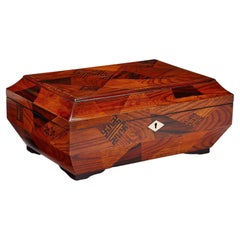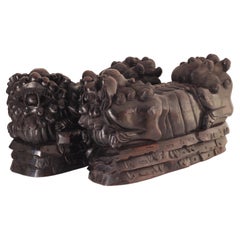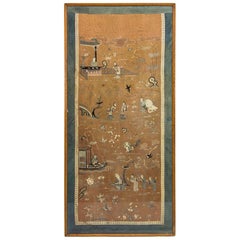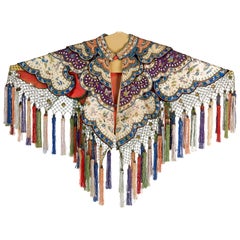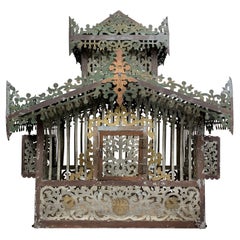1860s More Asian Art, Objects and Furniture
4
to
1
2
2
4
4
4
415
978
855
218
379
264
69
42
9
22
11
20
20
15
20
6
6
4
2
1
1
1
4
4
2
2
Period: 1860s
19th Century Japanese Elm and Calamander Parquetry Sarcophagus Work Box
Located in Henley-on-Thames, Oxfordshire
A mid 19th century Japanese export elm and calamander parquetry workbox with a divided interior and lift out tray.
This charming box would work e...
Category
Japanese Anglo-Japanese Antique 1860s More Asian Art, Objects and Furniture
Materials
Elm
A pair of 19th Century carved Foo temple dogs or Chinese guardian Lions
Located in London, GB
Chinese guardian lions, or imperial guardian lions, are a traditional Chinese architectural ornament. Typically made of stone, they are also known as stone lions or shishi (石獅; shíshī). They are known in colloquial English as lion dogs or foo dogs / fu dogs. The concept, which originated and became popular in Chinese Buddhism, features a pair of highly stylized lions—often one male with a ball and one female with a cub—which were thought to protect the building from harmful spiritual influences and harmful people that might be a threat. Used in imperial Chinese palaces and tombs, the lions subsequently spread to other parts of Asia including Japan (see komainu), Korea, Philippines, Tibet, Thailand, Myanmar, Vietnam, Sri Lanka, Nepal, Cambodia, Laos, and Malaysia.
There has been extensive interaction between Chinese mythology and Confucianism, Taoism, and Buddhism. Elements of pre-Han dynasty mythology such as those in Classic of Mountains and Seas were adapted into these belief systems as they developed (in the case of Taoism), or were assimilated into Chinese culture (in the case of Buddhism). Elements from the teachings and beliefs of these systems became incorporated into Chinese mythology. For example, the Taoist belief of a spiritual Paradise became incorporated into mythology as the place where immortals and deities used to dwell. Sometimes mythological and religious ideas have become widespread across China's many regions and diverse ethnic societies. In other cases, beliefs are more limited to certain social groups, for example, the veneration of white stones by the Qiang. One mythological theme that has a long history and many variations involves a shamanic world view, for example in the cases of Mongolian shamanism among the Mongols, Hmong shamanism among the Miao people, and the shamanic beliefs of the Qing dynasty from 1643 to 1912, derived from the Manchus. Politically, mythology was often used to legitimize the dynasties of China, with the founding house of a dynasty claiming a divine descent.
Mythology and philosophy.
Further information: Chinese philosophy
True mythology is distinguished from philosophical treatises and theories. Elaborations on the Wu Xing are not really part of mythology, although belief in five elements could appear. The Hundred Schools of Thought is a phrase suggesting the diversity of philosophical thought that developed during the Warring States of China. Then, and subsequently, philosophical movements had a complicated relationship with mythology. However, as far as they influence or are influenced by mythology, divides the philosophical camps into two rough halves, a Liberal group and a Conservative group. The liberal group being associated with the idea of individuality and change, for example as seen in the mythology of divination in China, such as the mythology of the dragon horse that delivered the eight bagua diagrams to Fu Xi, and methods of individual empowerment as seen in the Yi Jing (Book of Changes). The Liberal tendency is towards individual freedom, Daoism, and Nature. The relationship of the Conservative philosophies to mythology is seen in the legendary Nine Tripod Cauldrons, mythology about the emperors and central bureaucratic governance, Confucianism, written histories, ceremonial observances, subordination of the individual to the social groups of family and state, and a fixation on stability and enduring institutions. The distinction between the Liberal and Conservative is very general, but important in Chinese thought. Contradictions can be found in the details, however these are often traditional, such as the embrace by Confucius of the philosophical aspects of the Yi Jing, and the back-and-forth about the Mandate of Heaven wherein one dynasty ends and another begins based according to accounts (some of heavily mythological) where the Way of Heaven results in change, but then a new ethical stable dynasty becomes established. Examples of this include the stories of Yi Yin, Tang of Shang and Jie of Xia or the similar fantastic stories around Duke of Zhou and King Zhou of Shang.
Mythology exists in relationship with other aspects of society and culture, such as ritual. Various rituals are explained by mythology. For example, the ritual burning of mortuary banknotes (Hell Money), lighting fireworks, and so on.
A good example of the relationship of Chinese mythology and ritual is the Yubu, also known as the Steps or Paces of Yu. During the course of his activities in controlling the Great Flood, Yu was supposed to have so fatigued himself that he lost all the hair from his legs and developed a serious limp. Daoist practitioners sometimes incorporate a curiously choreographed pedal locomotion into various rituals. Mythology and practice, one explains the other: in these rituals, the sacred time of Yu merges with the sacral practice of the present.
Various ideas about the nature of the earth, the universe, and their relationship to each other have historically existed as either a background or a focus of mythologies. One typical view is of a square earth separated from a round sky by sky pillars (mountains, trees, or undefined). Above the sky is the realm of Heaven, often viewed of as a vast area, with many inhabitants. Often the heavenly inhabitants are thought to be of an "as above so below" nature, their lives and social arrangements being parallel to those on earth, with a hierarchical government run by a supreme emperor, many palaces and lesser dwellings, a vast bureaucracy of many functions, clerks, guards, and servants. Below was a vast under ground land, also known as Diyu, Yellow Springs, Hell, and other terms. As time progressed, the idea of an underground land in which the souls of the departed were punished for their misdeeds during life became explicit, related to developments in Daoism and Buddhism. The underground world also came to be conceived of as inhabited by a vast bureaucracy, with kings, judges, torturers, conductors of souls, minor bureaucrats, recording secretaries, similar to the structure of society in the Middle Kingdom (earthly China).
Chinese temple Dogs...
Category
Chinese Chinese Export Antique 1860s More Asian Art, Objects and Furniture
Materials
Hardwood
Chinese Silk Embroidery
Located in Wilson, NC
This Chinese silk embroidery depicts Mandarin figures, birds, elephants, butterflies, dragonflies, and willow trees. It is framed with a molded...
Category
Chinese Antique 1860s More Asian Art, Objects and Furniture
Materials
Silk, Glass, Oak
Japanese Edo Period Lacquer Panel with Gold, Mother of Pearl and Coral Inlay
Located in New York, NY
Japanese Edo period single panel table screen finely ornate with gold, mother of pearl and coral, lacquered. The scene depicts birds and flowers and is executed on Paloma wood, place...
Category
Japanese Edo Antique 1860s More Asian Art, Objects and Furniture
Materials
Coral, Gold
Related Items
Pair of Chinese Black Marble Contemporary Facing Foo Dogs Guardian Lions
Located in Yonkers, NY
A pair of contemporary Chinese black marble left and right facing foo dogs guardian lions on rectangular bases. Created in China during the 21st century, this pair of black marble gu...
Category
Chinese 1860s More Asian Art, Objects and Furniture
Materials
Marble
Rare Chinese Yun Jian Embroidered Silk Cloud Collar, circa 1880
Located in Bishop's Stortford, Hertfordshire
An exceptional and rare antique Chinese Yun Jian embroidered silk cloud collar dating from circa 1880. The collar is beautifully hand embroidered on colored s...
Category
Chinese Qing Antique 1860s More Asian Art, Objects and Furniture
Materials
Silk
Free Shipping
H 23.63 in W 29.93 in D 0.4 in
Antique Chinese Embroidery Tapestry
Located in Saint Ouen, FR
Beautiful antique embroidery from China late 19th century with very nice Chinese design with birds, flowers and personages, and beautiful purple color silk foundation, entirely hand ...
Category
Chinese Chinoiserie Antique 1860s More Asian Art, Objects and Furniture
Materials
Silk
19th Century Chinese Silk Embroidery ( 1'6'' X 4' - 46 X 122 )
Located in New York, NY
19th Century Chinese Silk Embroidery ( 1'6'' X 4' - 46 X 122 )
Category
Chinese Antique 1860s More Asian Art, Objects and Furniture
Materials
Silk
Japanese Powder Horn with Inlay in Mother of Pearl, 19th Century
Located in Stockholm, SE
A fantastic Japanese powder horn. The horn has inlay of mother of pearl in the shape of a grasshopper. The Japanese craftsmanship at its best.
Category
Japanese Antique 1860s More Asian Art, Objects and Furniture
Materials
Horn
Pair of Edo Period Black and Gold Lacquer Samurai Helmet Boxes
Located in Lymington, Hampshire
A pair of Edo period black and gold lacquer Samurai helmet boxes (Hakko Bako), each of ribbed cylindrical form with a lid, a black lacquer interior,...
Category
Japanese Edo Antique 1860s More Asian Art, Objects and Furniture
Materials
Lacquer
Chinese Green Glazed Foo Lions, Near Pair, Late 19th Century, China
Located in Austin, TX
A charming near pair of Chinese green glazed foo lion joss stick holders, late 19th century, China.
The delightful foo lions, also referred to as foo dogs, crafted as joss (incens...
Category
Chinese Qing Antique 1860s More Asian Art, Objects and Furniture
Materials
Stoneware
Chinese Dragon, Framed Silk Textile Embroidery
Located in Delray Beach, FL
Vintage Chinese textile, with a finely detailed nicely dragon embroidery on red silk background. Displayed in a contemporary gold wood fram...
Category
Chinese 1860s More Asian Art, Objects and Furniture
Materials
Silk
Japanese Cast Bronze "Longevity" Mirror, Edo Period, 18th Century, Japan
Located in Austin, TX
A heavy and finely cast Japanese bronze mirror with longevity symbols, Edo Period, 18th century, Japan.
The small, round mirror with high walls...
Category
Japanese Edo Antique 1860s More Asian Art, Objects and Furniture
Materials
Bronze
Japanese Antique Small Wooden Drawer / 1865-1868 / Late Edo Period / Storage Box
Located in Sammu-shi, Chiba
This is a small Japanese wooden drawer.
I think it's a drawer that was used in shops and other places where small tools were put.
The handle is made of iron.
It is a cool drawer...
Category
Japanese Edo Antique 1860s More Asian Art, Objects and Furniture
Materials
Cedar
H 12.37 in W 16.54 in D 8.47 in
19th Century Chinese Silk Embroidery Panel
Located in Rio Vista, CA
Exquisite piece of antique embroidery from the 19th century with supporting documents from Hong Kong. Two sleeves of high officials combined to create an intricate panel. The art tel...
Category
Chinese Qing Antique 1860s More Asian Art, Objects and Furniture
Materials
Silk, Plexiglass, Wood
Japanese Porcelain Plate, Japan, End of the 19th Century
Located in Roma, IT
You are admiring a refined Japanese Porcelain plate made by Japan manufacture during the end of the 19th century.
This elegant decorative ...
Category
Japanese Antique 1860s More Asian Art, Objects and Furniture
Materials
Porcelain
Previously Available Items
Kitsune (Fox) Known As "Hakuzosu" Dressed as a Monk, Japanese, Wood, Meiji
Located in Point Richmond, CA
Kitsune (Fox), known as "Hakuzosu”, dressed as a monk, is a popular figure in Japanese folklore.
The detail of the carving is extraordinary, with the graceful folds of the robe obsc...
Category
Japanese Meiji Antique 1860s More Asian Art, Objects and Furniture
Materials
Wood
19th Century Pierced Metal Work Asian Birdcage
Located in Hastings, GB
A highly unusual and stunningly detailed pierced work metal birdcage, in the form of an Asian Pagoda, dating to the 19th century, this piece is likely to originate from Japan or poss...
Category
Japanese Japonisme Antique 1860s More Asian Art, Objects and Furniture
Materials
Metal
Antique Hair Pins in Silver and Ivory, Mid-19th Century
Located in New York, NY
A group of three antique hairpins, crafted in silver and topped with ivory and silver filigree on top.
From old Indochina (Vietnam), circa 1860. The ...
Category
Vietnamese Qing Antique 1860s More Asian Art, Objects and Furniture
Materials
Silver
Chinese circa 1860 Antique Victorian Original Paint Carved Wood Wall Panel
Located in GB
We are delighted to offer for sale this lovely circa 1860 hand carved and painted Chinese wall panel
A very good looking and well made p...
Category
Chinese Victorian Antique 1860s More Asian Art, Objects and Furniture
Materials
Wood
H 47.25 in W 9.65 in D 1.19 in
Qing Dynasty 19th Century Rosefamily Jaune Blue Pink Green Ceramic Vase With Lid
Located in Valladolid, ES
One of a kind Chinese ceramic vase with a foo lion lid. On a marvelous yellow, hand painted chrysanthemums, peonies or different Chinese symbols in shades of ...
Category
Chinese Qing Antique 1860s More Asian Art, Objects and Furniture
Materials
Ceramic
H 20.08 in W 11.82 in D 11.82 in
19th Century Food Box
Located in New York, NY
A 19th century Chinese food box. Woven & turned bamboo with fruit wood crafted into a food box container. Associated with serving Dim Sum. Dec...
Category
Chinese Qing Antique 1860s More Asian Art, Objects and Furniture
Materials
Bamboo, Fruitwood
19th Century Chinese Silver Oxen Boxes
Located in Savannah, GA
Pair of Chinese embossed silver oxen trinket boxes or incense burners with inlaid coral, turquoise and mother-of-pearl. Very detailed with symbols of eyes on removable lids. Unmarked...
Category
Chinese Qing Antique 1860s More Asian Art, Objects and Furniture
Materials
Coral, Multi-gemstone, Sterling Silver
Recently Viewed
View AllMore Ways To Browse
Antique Tibetan Coral Beads
Antique Chinese Lunch Box
Jain Marble
Jomon Period
Chinese Hair Comb
Tibet Drum
Edo Chair
Vintage Bonsai Pots
Chinese Handled Lunch Box
Vintage Bonsai Pot
Asian Lunch Box
Saga Pottery
Conch Trumpet
Trumpet Conch
Hand Carved White Jade Buddha
Glass Overlay Chinese Snuff Bottle
Walking Buddha
Burmese Terracotta
